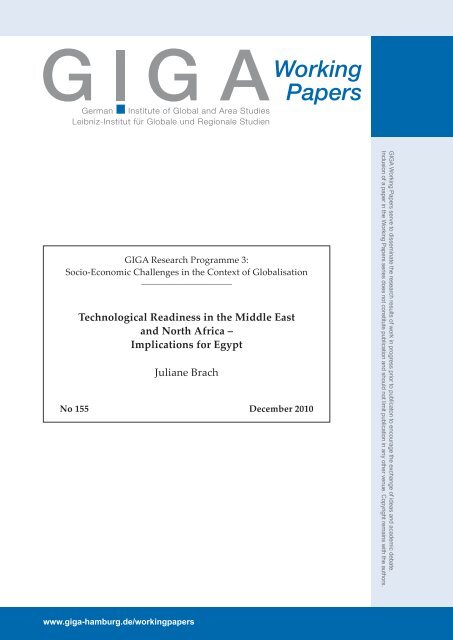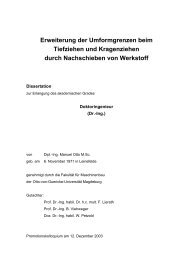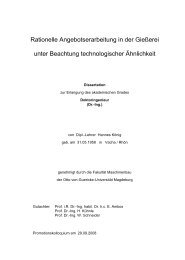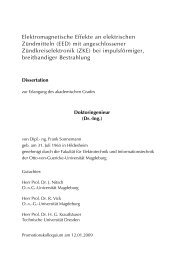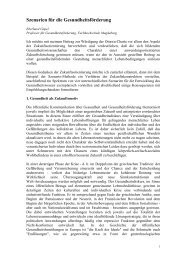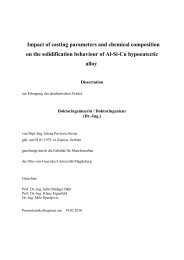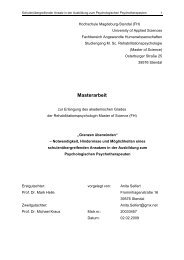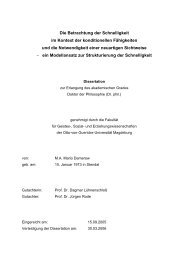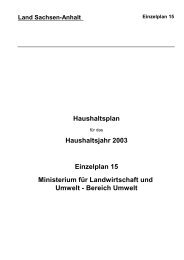Download PDF - GIGA German Institute of Global and Area Studies
Download PDF - GIGA German Institute of Global and Area Studies
Download PDF - GIGA German Institute of Global and Area Studies
You also want an ePaper? Increase the reach of your titles
YUMPU automatically turns print PDFs into web optimized ePapers that Google loves.
<strong>GIGA</strong> Research Programme 3:<br />
Socio-Economic Challenges in the Context <strong>of</strong> <strong>Global</strong>isation<br />
___________________________<br />
Technological Readiness in the Middle East<br />
<strong>and</strong> North Africa –<br />
Implications for Egypt<br />
Juliane Brach<br />
No 155 December 2010<br />
www.giga-hamburg.de/workingpapers<br />
<strong>GIGA</strong> Working Papers serve to disseminate the research results <strong>of</strong> work in progress prior to publicaton to encourage the exchange <strong>of</strong> ideas <strong>and</strong> academic debate.<br />
Inclusion <strong>of</strong> a paper in the Working Papers series does not constitute publication <strong>and</strong> should not limit publication in any other venue. Copyright remains with the authors.
<strong>GIGA</strong> Working Papers<br />
Edited by the<br />
<strong>GIGA</strong> <strong>German</strong> <strong>Institute</strong> <strong>of</strong> <strong>Global</strong> <strong>and</strong> <strong>Area</strong> <strong>Studies</strong><br />
Leibniz‐Institut für <strong>Global</strong>e und Regionale Studien<br />
<strong>GIGA</strong> WP 155/2010<br />
The <strong>GIGA</strong> Working Papers series serves to disseminate the research results <strong>of</strong> work in pro‐<br />
gress prior to publication in order to encourage the exchange <strong>of</strong> ideas <strong>and</strong> academic debate.<br />
An objective <strong>of</strong> the series is to get the findings out quickly, even if the presentations are less<br />
than fully polished. Inclusion <strong>of</strong> a paper in the <strong>GIGA</strong> Working Papers series does not consti‐<br />
tute publication <strong>and</strong> should not limit publication in any other venue. Copyright remains<br />
with the authors. When working papers are eventually accepted by or published in a journal<br />
or book, the correct citation reference <strong>and</strong>, if possible, the corresponding link will then be<br />
included on the <strong>GIGA</strong> Working Papers website at .<br />
<strong>GIGA</strong> research unit responsible for this issue:<br />
<strong>GIGA</strong> Research Programme 3: “Socio‐Economic Challenges in the Context <strong>of</strong> <strong>Global</strong>isation”<br />
Editor <strong>of</strong> the <strong>GIGA</strong> Working Papers series: Bert H<strong>of</strong>fmann<br />
<br />
Copyright for this issue: © Juliane Brach<br />
English copy editor: Meenakshi Preisser<br />
Editorial assistant <strong>and</strong> production: Silvia Bücke<br />
All <strong>GIGA</strong> Working Papers are available online <strong>and</strong> free <strong>of</strong> charge on the website<br />
.<br />
For any requests please contact:<br />
E‐mail: workingpapers@giga‐hamburg.de<br />
Phone: ++49 (0)40 ‐ 4 28 25 ‐ 548<br />
The <strong>GIGA</strong> <strong>German</strong> <strong>Institute</strong> <strong>of</strong> <strong>Global</strong> <strong>and</strong> <strong>Area</strong> <strong>Studies</strong> cannot be held responsible for errors<br />
or any consequences arising from the use <strong>of</strong> information contained in this Working Paper;<br />
the views <strong>and</strong> opinions expressed are solely those <strong>of</strong> the author or authors <strong>and</strong> do not neces‐<br />
sarily reflect those <strong>of</strong> the <strong>Institute</strong>.<br />
<strong>GIGA</strong> <strong>German</strong> <strong>Institute</strong> <strong>of</strong> <strong>Global</strong> <strong>and</strong> <strong>Area</strong> <strong>Studies</strong><br />
Leibniz‐Institut für <strong>Global</strong>e und Regionale Studien<br />
Neuer Jungfernstieg 21<br />
20354 Hamburg<br />
<strong>German</strong>y<br />
E‐mail: info@giga‐hamburg.de<br />
Website: www.giga‐hamburg.de
<strong>GIGA</strong> WP 155/2010<br />
Technological Readiness in the Middle East <strong>and</strong> North Africa –<br />
Abstract<br />
Implications for Egypt<br />
Innovation is widely recognized as a key driver <strong>of</strong> sustainable economic development. Gov‐<br />
ernments, international organizations, donors <strong>and</strong> investors are increasingly interested in<br />
evaluating the technological capabilities <strong>and</strong> innovative capacities in developing countries,<br />
but <strong>of</strong>ten lack appropriate approaches for such measurement. This paper focuses on innova‐<br />
tion <strong>and</strong> technological progress in the MENA region <strong>and</strong> discusses the challenges <strong>of</strong> under‐<br />
st<strong>and</strong>ing, exp<strong>and</strong>ing <strong>and</strong> fostering innovative potential in Egypt.<br />
Keywords: Egypt, Middle East, North Africa, Technology, Developing countries<br />
J‐Pr<strong>of</strong>. Dr. Juliane Brach<br />
is assistant research pr<strong>of</strong>essor at the Department <strong>of</strong> Economics, University <strong>of</strong> Copenhagen;<br />
a research fellow at the <strong>GIGA</strong> <strong>Institute</strong> <strong>of</strong> Middle East <strong>Studies</strong><br />
Contact: brach@giga‐hamburg.de<br />
Website: http://staff.en.giga‐hamburg.de/brach<br />
Contact: juliane.brach@econ.ku.dk<br />
Website: http:/www./econ.ku.dk
Zusammenfassung<br />
<strong>GIGA</strong> WP 155/2010<br />
Technologische Anpassungsfähigkeit im Nahen Osten und Nordafrika – Auswirkungen<br />
auf Ägypten<br />
Innovation wird weithin als eine treibende Kraft von nachhaltiger wirtschaftlicher Entwick‐<br />
lung angesehen. Regierungen, internationale Organisationen, Geber von Entwicklungshilfe<br />
und Investoren haben ein zunehmendes Interesse daran, die technologischen Fertigkeiten und<br />
die innovative Leistungsfähigkeit von Entwicklungsländern zu beurteilen, häufig mangelt es<br />
jedoch an geeigneten Ansätzen für eine solche Untersuchung. Dieses Paper untersucht den<br />
Fortschritt in den Bereichen Innovation und Technologie in der MENA‐Region und diskutiert<br />
die Herausforderungen, die das Verstehen, Ausweiten und Fördern des innovativen Potenzials<br />
in Ägypten darstellen.
Technological Readiness in the Middle East <strong>and</strong> North Africa –<br />
Implications for Egypt*<br />
Article Outline<br />
1 Introduction<br />
2 Related Literature: An Overview<br />
3 Methodology <strong>and</strong> Data<br />
4 Empirical Results<br />
5 Discussion<br />
6 Implications for Egypt<br />
7 Conclusion<br />
1 Introduction<br />
Juliane Brach<br />
In an international comparison with peer economies, the economy <strong>of</strong> the Arab Re‐<br />
public <strong>of</strong> Egypt displays relatively low growth rates. These are coupled with high<br />
rates <strong>of</strong> population growth <strong>and</strong> a very tight labor market. One <strong>of</strong> the major challenges<br />
in the near future, for Egypt as much as for the other Arab countries in the Middle<br />
East <strong>and</strong> North Africa (MENA), is sustainable job creation (Nabli 2007).<br />
There is ample economic literature on the existing growth deficit <strong>and</strong> weak eco‐<br />
nomic performance <strong>of</strong> Arab MENA countries. However, little research has investi‐<br />
gated the constraints on economic development in the Arab MENA countries that
6<br />
Juliane Brach: Technological Readiness in the Middle East <strong>and</strong> North Africa – Implications for Egypt<br />
might explain why they perform below their potential. Underst<strong>and</strong>ing the most<br />
binding constraints to economic development <strong>and</strong> growth is a prerequisite for identi‐<br />
fying effective structural adjustment measures, both nationally <strong>and</strong> internationally.<br />
National governments, as well as international organizations, have only limited fi‐<br />
nancial <strong>and</strong> administrative resources to dedicate to structural adjustment <strong>and</strong> devel‐<br />
opment support. Rarely, if ever, is it possible to tackle all constraints. Policymakers<br />
have to make choices <strong>and</strong> set priorities to ensure that their efforts <strong>and</strong> the available<br />
resources are directed toward alleviating the most binding constraints.<br />
The central aim <strong>of</strong> this paper is to take a closer look at the technological progress<br />
<strong>and</strong> innovative activities in the MENA region in order to underst<strong>and</strong> the challenges<br />
<strong>and</strong> limitations <strong>of</strong> sustainable economic performance <strong>and</strong> job creation as well as to<br />
best possibly support policymakers’ decision‐making processes in this context.<br />
The remainder <strong>of</strong> the paper is organized as follows: Section 2 provides an over‐<br />
view <strong>of</strong> the related literatures. Sections 3 <strong>and</strong> 4 present the methodology <strong>and</strong> the re‐<br />
sults <strong>of</strong> the empirical analysis, respectively. Section 5 discusses the more general im‐<br />
plications <strong>of</strong> the empirical results, while Section 6 concentrates on the implications<br />
for the case <strong>of</strong> Egypt. Section 7 concludes.<br />
2 Related Literature: An Overview<br />
Traditionally, growth theory focused on physical <strong>and</strong> human capital accumulation as<br />
the ultimate sources <strong>of</strong> growth. Today, economists <strong>and</strong> policymakers alike recognize<br />
innovation as a key driver <strong>of</strong> economic growth <strong>and</strong> development (OECD 2009). The<br />
body <strong>of</strong> literature on innovation is vast <strong>and</strong> covers an extensive variety <strong>of</strong> subjects.<br />
Drawing on Schumpeter’s seminal contribution from 1950, theoretical advances were<br />
made in the 1990s (by Romer, Aghion <strong>and</strong> Howitt, <strong>and</strong> by Grossman <strong>and</strong> Helpman,<br />
among others) <strong>and</strong> were followed by a substantial increase in empirical studies.<br />
These studies center almost exclusively on the analysis <strong>of</strong> research <strong>and</strong> development<br />
(R&D)‐intensive activities <strong>and</strong> sectors in OECD countries, where over 90 percent <strong>of</strong><br />
recent technologies have been developed. Innovation in developing countries has<br />
only rarely been an explicit research subject.<br />
Early exceptions are Basu <strong>and</strong> Weil (1998) <strong>and</strong> Hausman <strong>and</strong> Rodrik (2003), who<br />
have argued that developing countries face a technology bias <strong>and</strong> need to appropri‐<br />
ate existing technologies, <strong>and</strong> that this process <strong>of</strong> technology adoption is not cost‐free<br />
but rather as uncertain as the innovation process in the OECD countries. In general,<br />
the bulk <strong>of</strong> the literature on economic development in developing countries has con‐<br />
centrated on these countries’ access to international technologies through interna‐<br />
tional trade rather than on their innovative <strong>and</strong> creative capacities (e.g. Sachs <strong>and</strong><br />
Warner 1999; Dollar <strong>and</strong> Kraay 2004). More recently, the interest in “incremental” or
Juliane Brach: Technological Readiness in the Middle East <strong>and</strong> North Africa – Implications for Egypt 7<br />
“inside‐frontier” innovation <strong>and</strong> technological capacity as important drivers <strong>of</strong> de‐<br />
velopment in developing countries has been increasing. The need for further theo‐<br />
retical <strong>and</strong> empirical research in this direction has been underscored <strong>and</strong> encouraged<br />
by leading researchers (e.g. Fagerberg et al. 2009; Freeman <strong>and</strong> Soete 2009) <strong>and</strong> re‐<br />
search institutions (e.g. OECD–UNESCO 2009).<br />
Despite the plethora <strong>of</strong> scholarly articles <strong>and</strong> international organizations’ publica‐<br />
tions on economic growth in various countries <strong>and</strong> regions <strong>of</strong> the world, the contribu‐<br />
tions on economic growth performance in MENA countries remain limited. Important<br />
components <strong>of</strong> the existing literature on MENA growth use the aggregate “MENA<br />
region” (Sala‐I‐Martin <strong>and</strong> Artadi 2003; Aubert 2004; Dasgupta 2003). The definition<br />
<strong>of</strong> the region varies significantly from study to study but generally covers around<br />
twenty countries, including Iran, Turkey <strong>and</strong> Israel. Consequently, these studies yield<br />
only very general <strong>and</strong> generic observations. Only few papers investigate MENA eco‐<br />
nomic growth at a more disaggregated level. Bisat et al. (1997) provide a detailed<br />
analysis <strong>of</strong> the economic growth rates <strong>of</strong> ten Arab MENA countries based on a<br />
growth accounting exercise (for the years 1971–96). They find that the investment<br />
process that took place over those years was not accompanied by sufficient im‐<br />
provement in total factor productivity (TFP). In fact, the average annual TFP growth<br />
was negative over the whole period. More recently, Abu‐Qarn <strong>and</strong> Abu‐Bader (2007)<br />
have revisited the sources <strong>of</strong> MENA growth <strong>and</strong> have attempted to determine the<br />
key factors that led to economic growth in MENA countries over the period 1960–98.<br />
They found that MENA growth performance was essentially determined by physical<br />
capital accumulation <strong>and</strong>, to a lesser extent, by the accumulation <strong>of</strong> human capital.<br />
The contribution <strong>of</strong> TFP to economic growth was negligible; all six Arab MENA<br />
countries exhibit negative TFP growth. Nabli <strong>and</strong> Véganzonès‐Varoudakis (2007)<br />
address the empirical link between economic reform, human capital, <strong>and</strong> physical<br />
infrastructure <strong>and</strong> MENA economic growth. They find a strong positive impact from<br />
advances in physical infrastructure <strong>and</strong> human capital, <strong>and</strong> a negative impact from<br />
structural reform on growth in six MENA countries over the period from 1970 to<br />
1999. A very recent study also points to a severe lack <strong>of</strong> technological capacities <strong>and</strong><br />
innovative activities in the MENA region <strong>and</strong> shows that region‐specific features<br />
such as rent‐ <strong>and</strong> continuity‐oriented political economy structures are simultane‐<br />
ously important determinants <strong>and</strong> hampering factors to economic development in<br />
the MENA region that can partially explain an economically inefficient allocation <strong>of</strong><br />
resources (Brach 2009).
8<br />
Juliane Brach: Technological Readiness in the Middle East <strong>and</strong> North Africa – Implications for Egypt<br />
3 Methodology <strong>and</strong> Data<br />
Equation (1) yields the extended core specification <strong>and</strong> baseline models in subse‐<br />
quent OLS <strong>and</strong> panel data regression analysis.<br />
ECDEVi = β1 + β2 EconInsti + β3 Techreadi + β4 Opennessi +<br />
+ β5 Marketsizei + β6 Oildependencei + β7 Conflicti +<br />
+ β8 Geographyi + β9 Regioni + β10 MENA*Technology + ε (1)<br />
β1 is the intercept <strong>and</strong> ε the r<strong>and</strong>om error term. Throughout the paper I will be inter‐<br />
ested in the sign, magnitude, <strong>and</strong> significance <strong>of</strong> the coefficients. The interaction<br />
terms allow me to explore <strong>and</strong> control for the special impact <strong>of</strong> these variables in<br />
MENA countries.<br />
The dependent variable “economic development” (ECDEV) <strong>of</strong> country i, is writ‐<br />
ten on the right‐h<strong>and</strong> side <strong>of</strong> the equation <strong>and</strong> is measured as the logarithm <strong>of</strong> per<br />
capita GDP. The independent variables that are presented on the left‐h<strong>and</strong> side <strong>of</strong> the<br />
equation can be sorted into four groups:<br />
1) science <strong>and</strong> technology indicators (STI) (including human capital),<br />
2) macroeconomic indicators,<br />
3) political economy indicators,<br />
4) context <strong>and</strong> control variables.<br />
Table 1 provides a list <strong>of</strong> the variables <strong>and</strong> data sources. A more detailed description<br />
<strong>and</strong> motivation <strong>of</strong> variables <strong>and</strong> indicators is provided by Brach (2009).<br />
In total, data have been collected for 189 countries for which the variables <strong>and</strong> their<br />
sources are described in the attached table.<br />
The biggest obstacle throughout the sample remains the availability <strong>of</strong> data from<br />
the Arab Middle Eastern <strong>and</strong> North African (AMENA) countries as well as ready <strong>and</strong><br />
applicable data including S&T indicators across all countries, which are documented<br />
in Table A.1 in the appendix.
Juliane Brach: Technological Readiness in the Middle East <strong>and</strong> North Africa – Implications for Egypt 9<br />
Table 1: Variables <strong>and</strong> Sources<br />
Variable group Variable<br />
Economic<br />
development<br />
Science <strong>and</strong><br />
Technology<br />
GDP per<br />
capita<br />
Technological<br />
readiness<br />
Model<br />
specification<br />
Economic<br />
development<br />
Description Source<br />
Logarithm <strong>of</strong> GDP per capita in constant<br />
prices, purchasing power parity (PPP), base‐<br />
line year 2005<br />
Technology Country’s level <strong>of</strong> technological readiness,<br />
values ranging from 1 to 7<br />
(World Bank<br />
2010)<br />
(WEF 2007)<br />
Patents Science Logarithm <strong>of</strong> patent applications by residents (World Bank 2010)<br />
Technicians Science Technicians in R&D (per million people) (World Bank 2010)<br />
Researchers Science Researchers in R&D (per million people) (World Bank 2010)<br />
High‐techno‐<br />
logy exports<br />
R&D<br />
expenditure<br />
Technology Logarithm <strong>of</strong> high‐technology exports (% <strong>of</strong><br />
manufactured exports)<br />
Technology Logarithm <strong>of</strong> research <strong>and</strong> development<br />
expenditure (% <strong>of</strong> GDP)<br />
Adult literacy Education Adult literacy rate (% <strong>of</strong> population aged 15<br />
years <strong>and</strong> over)<br />
Education<br />
index<br />
Economy Fuel exports Oil<br />
dependence<br />
Education Index ranging from 0 to 1, with a higher<br />
score indicating higher education. Based on<br />
the adult literacy rate <strong>and</strong> the combined<br />
gross enrollment ratio for primary, secon‐<br />
dary, <strong>and</strong> tertiary schools.<br />
Logarithm <strong>of</strong> fuel exports (% <strong>of</strong> merch<strong>and</strong>ise<br />
exports)<br />
Openness Openness Percentage <strong>of</strong> exports <strong>and</strong> imports <strong>of</strong> goods<br />
<strong>and</strong> services to GDP in constant 2000 prices<br />
(World Bank 2010)<br />
(World Bank 2010)<br />
(Human Devel‐<br />
opment Indicators,<br />
UNDP 2009)<br />
(Human Devel‐<br />
opment Indica‐<br />
tors, UNDP<br />
2009)<br />
(World Bank 2010)<br />
(World Bank 2010)<br />
Population Market size Logarithm <strong>of</strong> population, in millions (World Bank 2010)<br />
Economic<br />
institutions<br />
Economic<br />
institutions<br />
Composite index <strong>of</strong> economic freedom, in‐<br />
cluding a set <strong>of</strong> six indicators <strong>of</strong> economic<br />
institutions: business regulations, fiscal bur‐<br />
den, property rights, restrictions on invest‐<br />
ment, capital market restrictions, <strong>and</strong> labor<br />
market rigidity. Values range from 0 to 100,<br />
combining survey <strong>and</strong> hard data<br />
Context Conflict Conflict Number <strong>and</strong> intensity <strong>of</strong> internal <strong>and</strong> exter‐<br />
nal conflicts<br />
Distance from<br />
equator<br />
L<strong>and</strong>locked<br />
status<br />
Source: Author’s compilation<br />
Geography Distance <strong>of</strong> capital city from equator, meas‐<br />
ured as the absolute value <strong>of</strong> latitude<br />
<strong>Area</strong> Dummy variable taking value 1 for countries<br />
without access to the sea, 0 otherwise<br />
Dummies D_LAC Latin America <strong>and</strong> Caribbean<br />
D_EAP East Asia <strong>and</strong> Pacific<br />
D_ECA Europe <strong>and</strong> Central Asia<br />
D_SSA Sub‐Saharan Africa<br />
D_SA South Asia<br />
D_AMENA<br />
D_MED<br />
Arab MENA country<br />
Arab Mediterranean country<br />
D_EUROPE European continent<br />
D_ASIA Asian continent<br />
D_OCEANIA Oceania continent<br />
D_AFRICA African continent<br />
D_SOUTH<br />
AMERICA<br />
D_NORTH<br />
AMERICA<br />
South American continent<br />
North American continent<br />
(Heritage Foun‐<br />
dation 2010)<br />
(CSCW 2009,<br />
Version 4)<br />
(Kaufmann et al.<br />
2005)<br />
(Kaufmann et al.<br />
2005)
10<br />
Juliane Brach: Technological Readiness in the Middle East <strong>and</strong> North Africa – Implications for Egypt<br />
The data used originate from a wide range <strong>of</strong> different sources <strong>of</strong> internationally<br />
recognized data <strong>and</strong> are as follows: The World Bank’s World Development Indicators<br />
comprise the backbone <strong>of</strong> the performed analysis, including reliable <strong>and</strong> comprehen‐<br />
sive data for the AMENA region. Nevertheless, data relating to S&T indicators, such<br />
as patents, R&D expenditure <strong>and</strong> employed technicians <strong>and</strong> researchers for the<br />
AMENA countries are severely lacking in the WDI database. As a result, the World<br />
Economic Forum’s <strong>Global</strong> Competitiveness Index is also included as a measure <strong>of</strong><br />
technology in the performed analysis. The data are based on an executive opinion<br />
survey (<strong>Global</strong> Opinion Survey, GOS) <strong>of</strong> over 10,000 enterprises worldwide, one <strong>of</strong><br />
the few sources that allow for cross‐country comparison.<br />
The data for ”economic institutions” are taken from the Heritage Foundation’s In‐<br />
dex <strong>of</strong> Economic Freedom <strong>and</strong> are based on a non‐weighted average <strong>of</strong> the measures <strong>of</strong><br />
business, fiscal, investment, financial, <strong>and</strong> labor freedoms, along with property rights.<br />
The Centre for the Study <strong>of</strong> Civil War (CSCW) <strong>of</strong> the Peace Research <strong>Institute</strong> in<br />
Oslo provides data on armed conflicts. The conflict measure in the current sample is<br />
based on CSCW’s Armed Conflicts Version 4‐2009 <strong>and</strong> measures the cumulative<br />
amount <strong>of</strong> armed conflict since 1970. Incidents are measured by intensity with inci‐<br />
dents resulting in between 25 <strong>and</strong> 999 battle‐related deaths in a given year catego‐<br />
rized as “minor” <strong>and</strong> given the value 1, <strong>and</strong> incidents with at least 1,000 battle‐<br />
related deaths in a given year considered “war” <strong>and</strong> given the value 2.<br />
Finally, literacy rate <strong>and</strong> education index data are provided by the United Na‐<br />
tions Development Programs Human Development Indicators, <strong>and</strong> geographical<br />
data <strong>of</strong> each country are based on the findings <strong>of</strong> Kaufmann et al. (2005).<br />
The sample covers 77 countries <strong>and</strong> unless reported otherwise, all data are taken<br />
from the year 2005. The base year for constant U.S. dollar prices in PPP is 2000. The<br />
quantitative data analysis is based on cross‐country regressions. As a result <strong>of</strong> con‐<br />
straints on data availability, only 5 out <strong>of</strong> a total <strong>of</strong> 19 AMENA countries are being<br />
included in the 2005 regression analysis.<br />
Table 2 summarizes the descriptive statistics for the key variables <strong>of</strong> interest.<br />
Table 2: Descriptive Statistics<br />
Mean Std. Deviation N<br />
LGGDP 3.9000 0.44946 77<br />
ECONINST 65.6802 9.28532 77<br />
TECHREAD 4.065 1.1905 77<br />
OPENNESS 87.868 43.5229 77<br />
MARKET 48.2295 153.39450 77<br />
FUELEX 15.55 24.524 77<br />
LGCONFL 0.5849 0.71410 77<br />
DISTEQ 32.81 17.515 77<br />
Source: Author’s calculations
Juliane Brach: Technological Readiness in the Middle East <strong>and</strong> North Africa – Implications for Egypt 11<br />
A combination <strong>of</strong> exploratory data analysis (EDA) <strong>and</strong> more rigorous testing was<br />
performed separately for each variable <strong>and</strong> bivariate relationship prior to the multi‐<br />
variate analysis.<br />
4 Empirical Results<br />
All but one explanatory variable show the expected signs consistently throughout the<br />
different models.<br />
Technological readiness has a highly significant, positive impact <strong>and</strong> a large eco‐<br />
nomic importance. The coefficients suggest that two‐thirds <strong>of</strong> the variation in economic<br />
development can actually be explained by a country’s technological readiness. Even<br />
after the inclusion <strong>of</strong> all dummy variables, the importance remains above 50 percent.<br />
Table 3: OLS 77 Countries—Economic Development (lgGDPPC)<br />
Economic Development (lgGDPPC)<br />
1 2 3 4 5 6 7 8<br />
ECONINST 0.23*** 0.21** 0.26*** 0.19* 0.05 0.01 ‐0.03 ‐0.04<br />
(2.62) (2.23) (2.65) (1.91) (0.58) (0.11) (‐0.30) (‐0.52)<br />
TECHREAD 0.65*** 0.65*** 0.63*** 0.65*** 0.62*** 0.63*** 0.67*** 0.53***<br />
(7.37) (7.24) (7.12) (7.53) (8.50) (8.65) (8.96) (6.57)<br />
OPENNESS 0.08 0.10 0.06 0.03 0.03 0.02 0.02<br />
(1.17) (1.43) (0.87) (0.43) (0.46) (0.42) (0.30)<br />
MARKET 0.03 0.05 0.07 ‐0.01 ‐0.02 ‐0.02 ‐0.01<br />
(0.42) (0.65) (0.97) (‐0.12) (‐0.32) (‐0.35) (‐0.24)<br />
OILDEP 0.12* 0.10*’ 0.06 0.06 0.02 0.00<br />
(1.79) (1.52) (0.98) (1.05) (0.30) (‐0.03)<br />
LGCONFL ‐0.17** ‐0.04 ‐0.03 ‐0.06 ‐0.09<br />
(‐2.32) (‐0.59) (‐0.46) (‐0.96) (‐1.41)<br />
DISTEQ 0.38*** 0.40*** 0.39*** 0.24**<br />
(5.56) (5.75) (5.63) (2.26)<br />
MED ‐0.08 0.43*’ 0.39*’<br />
(‐1.34) (1.51) (1.50)<br />
MED*TECH ‐0.52* ‐0.46*<br />
(‐1.81) (‐1.72)<br />
Regional no no no no no no no yes<br />
Dummies<br />
Adjusted R 2 0.67 0.67 0.67 0.70 0.78 0.79 0.80 0.84<br />
N 77 77 77 77 77 77 77 77<br />
Note: ***, **, <strong>and</strong> * denote a significance at the 1, 5, <strong>and</strong> 10 percent level, respectively.<br />
Source: Author’s calculations<br />
When first introduced in Model 6, the dummy for Arab Mediterranean countries<br />
(MED) displays a negative sign, but is positive thereafter. The explanation is rea‐<br />
sonably straightforward: Model 6 points out that the generally positive impact <strong>of</strong>
12<br />
Juliane Brach: Technological Readiness in the Middle East <strong>and</strong> North Africa – Implications for Egypt<br />
economic institutions, technological readiness, <strong>and</strong> the control variables might not<br />
hold true when analyzing economic development in AMCs when compared to other<br />
regions <strong>of</strong> the world, without being able to explain why. Models 7 <strong>and</strong> 8 are able to<br />
specify this finding: the negative impact <strong>of</strong> the MED dummy on economic develop‐<br />
ment stems from the negative impact <strong>of</strong> lacking technological readiness. While the<br />
MED dummy now has a positive sign, the interaction term <strong>of</strong> technological readiness<br />
<strong>and</strong> MED (TECH*MED) has a negative sign, <strong>and</strong> both significant economic <strong>and</strong> sig‐<br />
nificant statistical relevance (‐0.52** <strong>and</strong> ‐0.46**, in columns 7 <strong>and</strong> 8, respectively).<br />
In contrast, the impact <strong>of</strong> economic institutions (ECONINST) changes from posi‐<br />
tive (columns 1‐6) to negative (columns 7 <strong>and</strong> 8). These institutions also lose signifi‐<br />
cance <strong>and</strong> magnitude with the successive inclusion <strong>of</strong> more variables. This may be<br />
puzzling at first, but it supports the hypothesis that economic institutions matter <strong>and</strong><br />
that they are endogenously dependent on several determinants, the impact <strong>of</strong> which<br />
can be either in support <strong>of</strong> or an obstacle to economic development. This initial in‐<br />
dicative finding needs further investigation <strong>and</strong> interpretation, which will be pro‐<br />
vided in the next section.<br />
With respect to identifying the most binding constraints to the economic devel‐<br />
opment <strong>of</strong> the AMCs, the magnitude <strong>of</strong> the coefficients yields a sense <strong>of</strong> the potential<br />
impact. Model 8, which includes both the regional dummies <strong>and</strong> the interaction term,<br />
is a specification with a solid explanatory power <strong>of</strong> 84 percent (adjusted R2 ) <strong>and</strong> re‐<br />
veals that technological readiness <strong>and</strong> distance from the equator in general have re‐<br />
spectively a 53 percent <strong>and</strong> 24 percent return on economic development. Both find‐<br />
ings are in line with the importance <strong>of</strong> these two variables, as noted in the theoretical<br />
section. With respect to the AMCs, the positive impact <strong>of</strong> technological readiness<br />
almost diminishes. Adding the interaction term to the TECHREAD coefficient gives<br />
the more precise estimate <strong>of</strong> as little as 0.07, or 7 percent.<br />
5 Discussion<br />
The empirical results provide strong evidence that one <strong>of</strong> the major constraints to an<br />
improved economic performance <strong>and</strong> sustainable job creation is the general lack <strong>of</strong><br />
MENA countries’ technological capacities. Since innovation in these countries is<br />
closely linked to the adoption, refinement, <strong>and</strong> modification <strong>of</strong> existing technologies<br />
(also dubbed “inside‐frontier” or “diffusion‐based” innovation), innovation <strong>and</strong><br />
productivity are negatively impacted by the low level <strong>of</strong> technological readiness.<br />
These results have three important implications for both policymakers <strong>and</strong> research‐<br />
ers, as I will discuss below.<br />
First, developing countries such as MENA countries that are not, or only to a very<br />
low extent, capable <strong>of</strong> using <strong>and</strong> appropriating existing technologies efficiently, are
Juliane Brach: Technological Readiness in the Middle East <strong>and</strong> North Africa – Implications for Egypt 13<br />
not able to fully internalize the positive effects <strong>of</strong> technology transfer <strong>and</strong> technology<br />
spill‐over effects that relate to international trade <strong>and</strong> trade openness. Trade liberali‐<br />
zation is thus not very likely to have a “natural” positive effect. Rather, there has to<br />
be an explicit focus on the transfer <strong>of</strong> both technology <strong>and</strong> knowledge in order to<br />
ensure <strong>and</strong> facilitate a positive impact.<br />
Second, although there is now strong evidence for the fact that technological<br />
readiness is a major constraint, the reason for this remains only speculated upon.<br />
What exactly makes MENA economies less productive than economies in other re‐<br />
gions? Brach (2009) provides some fresh insights into economic institutions, yet there<br />
is still no explanation that is based on the ultimate unit <strong>of</strong> productivity <strong>and</strong> competi‐<br />
tiveness: the firm.<br />
Third, more research is needed in order for us to be able to underst<strong>and</strong> the tech‐<br />
nological <strong>and</strong> innovative capacities at the level <strong>of</strong> the firm. This would require 1) the<br />
availability <strong>of</strong> relevant, recent, <strong>and</strong> reliable firm‐level data <strong>and</strong> 2) new indicators <strong>and</strong><br />
approaches to complement st<strong>and</strong>ard (OECD‐inspired) innovation surveys.<br />
Economic performance will only gain momentum if it is possible to close the<br />
productivity <strong>and</strong> technology gap between the AMENA countries <strong>and</strong> the rest <strong>of</strong> the<br />
world, which will continue to widen unless urgent measures are taken. Thus, more<br />
research <strong>and</strong> political effort need to be directed towards not only underst<strong>and</strong>ing <strong>and</strong><br />
fostering technology diffusion within <strong>and</strong> into these countries but also conducting<br />
in‐depth investigations <strong>of</strong> their technological capacities.<br />
6 Implications for Egypt<br />
Egypt is at a crossroads <strong>of</strong> economic development. Despite an overall favorable set‐<br />
ting, such as a relatively high degree <strong>of</strong> economic diversification, good educational<br />
attainment <strong>and</strong> human capital, a large domestic market <strong>and</strong> a relatively low degree <strong>of</strong><br />
social inequality, it faces a high burden <strong>of</strong> subsidies, <strong>and</strong> large‐scale unemployment,<br />
especially among the youth <strong>and</strong> increasingly also among university graduates. The<br />
informal sector <strong>of</strong> the economy is already considerably large <strong>and</strong> is constantly grow‐<br />
ing. Innovation <strong>and</strong> improvisation are taking place on a daily basis in various indus‐<br />
tries. Egypt has a lot to <strong>of</strong>fer, <strong>and</strong> there does not seem to be a general lack <strong>of</strong> entrepre‐<br />
neurial competence, talent, or innovative capacity. However, Egypt seems to be unable<br />
to systematically transform innovative activities into knowledge <strong>and</strong> products, <strong>and</strong><br />
that inability is hampering its productivity <strong>and</strong> economic performance.<br />
Egypt is an economic hub in the region, especially for intra‐regional trade <strong>and</strong><br />
factor movements, not only because <strong>of</strong> its large domestic market, but also because <strong>of</strong><br />
its status as a political actor <strong>and</strong> benchmark. However, in terms <strong>of</strong> technological <strong>and</strong><br />
innovative capacities, Egypt does not rank among the top performers. MENA coun‐
14<br />
Juliane Brach: Technological Readiness in the Middle East <strong>and</strong> North Africa – Implications for Egypt<br />
tries face very different stages with respect to access to <strong>and</strong> mastering <strong>of</strong> recent tech‐<br />
nologies <strong>and</strong> can be broadly categorized – as the following table shows – into two<br />
groups: technology developer <strong>and</strong> technology user. Within the group <strong>of</strong> technology<br />
users, we identify three sub‐groups <strong>of</strong> countries: technology consumers, integrated tech‐<br />
nology users, <strong>and</strong> isolated technology users. Out <strong>of</strong> the 20 countries in the MENA region,<br />
only the three non‐Arab countries are classified as technology developers.<br />
Table 4: Technological Competences by Country Groups<br />
Country<br />
groups<br />
St<strong>and</strong>ard measures<br />
<strong>and</strong> available indica‐<br />
tors:<br />
Author‘s own compilation<br />
Access<br />
(recent technologies<br />
are generally available<br />
)<br />
trade openness, WTO<br />
membership, number<br />
<strong>of</strong> free trade agree‐<br />
ments, average tariff<br />
Adoption<br />
(available technologies<br />
are applied efficiently)<br />
total factor productivity,<br />
international competi‐<br />
tiveness, technological<br />
readiness, business<br />
sophistication<br />
Development<br />
(development <strong>of</strong><br />
new‐to‐country<br />
technologies)<br />
R&D expenditures,<br />
patents, number <strong>of</strong><br />
researchers<br />
Developer Israel, Iran, Turkey ++ ++ ++<br />
User Consumer:<br />
Bahrain, Qatar, Ku‐<br />
wait, Oman, Saudi<br />
Arabia, United Arab<br />
Emirates<br />
Integrated User:<br />
++ ++ -<br />
Tunisia, Jordan, Egypt,<br />
Morocco, Lebanon<br />
Isolated User:<br />
Algeria, Syria,<br />
++ +/- +/-<br />
Palestinian Territories,<br />
Yemen, Libya, Iraq<br />
‐<br />
+/‐<br />
‐‐<br />
Technology developers are technologically well advanced <strong>and</strong> are characterized by<br />
excellent access to, <strong>and</strong> mastering <strong>and</strong> development <strong>of</strong>, new technologies through<br />
both research <strong>and</strong> technology adoption. Countries within this group in the MENA<br />
region are Israel, Turkey <strong>and</strong>, to some degree, Iran. All three have invested early <strong>and</strong><br />
systematically into education <strong>and</strong> the development <strong>of</strong> national innovative, science,<br />
<strong>and</strong> research capacities. They also pr<strong>of</strong>it from well‐educated nationals returning to<br />
their home country. All other countries in the region generally depend on foreign<br />
technologies, because they do not – or, if they do, then only to a very limited extent –<br />
develop or improve technologies according to their needs. Among the technology<br />
users, the technology consumers are highly integrated into the global market <strong>and</strong> thus<br />
have access to international, state‐<strong>of</strong>‐the‐art technologies. In contrast to the users,<br />
especially the more advanced users like those in Tunisia or Jordan, Gulf countries do<br />
not possess the necessary skills, but they do have the funds to equip themselves with<br />
both the technologies <strong>and</strong> the experts to manage them. The integrated technology users<br />
have (through systematic trade opening) improved their access to international tech‐
Juliane Brach: Technological Readiness in the Middle East <strong>and</strong> North Africa – Implications for Egypt 15<br />
nologies; however, neither the more advanced users like those in Tunisia <strong>and</strong> Jordan<br />
nor users in Egypt <strong>and</strong> Morocco have in the past ten years experienced the significant<br />
productivity improvement that was anticipated. This anticipation was based on<br />
analogies to other developing regions, but, as recent studies show, many MENA<br />
countries lack the necessary capacities to exploit the new (technological) opportuni‐<br />
ties to which they have now access (Brach 2009). Finally, the isolated technology users<br />
face the most difficult situation. Their integration into the world market is fairly re‐<br />
cent <strong>and</strong> rather selective (Syria, Algeria, <strong>and</strong> especially Libya), or has been delayed or<br />
harmed because <strong>of</strong> ongoing war <strong>and</strong> conflict (Iraq <strong>and</strong> the Palestinian territories).<br />
Countries in this group lack capacities, funds, <strong>and</strong> most <strong>of</strong> the basic infrastructure.<br />
Egypt is an integrated technology user <strong>and</strong> displays only a limited ability to suffi‐<br />
ciently use <strong>and</strong> apply existing technologies to spur sustainable economic develop‐<br />
ment, as is depicted in Graph 1. The access to recent technologies is still the necessary<br />
condition to economic growth, but it is not sufficient if the capacities to use, refine,<br />
<strong>and</strong> apply these technologies are limited <strong>and</strong> not well established.<br />
Graph 1: Economic Performance <strong>and</strong> Technological Capacities<br />
log per-capita gdp<br />
3 3.5 4 4.5<br />
ALG<br />
MOR<br />
EGY<br />
JOR<br />
OMA<br />
2 3 4 5 6 7<br />
level <strong>of</strong> technological readiness<br />
Source: Own calculations based on World Bank 2008 <strong>and</strong> World Economic Forum 2008<br />
TUN<br />
The relatively low impact <strong>of</strong> the current economic crisis on Egypt gives its govern‐<br />
ment room to maneuver <strong>and</strong> the opportunity to adjust to <strong>and</strong> develop sustainable<br />
<strong>and</strong> innovation‐based sources <strong>of</strong> growth (Brach <strong>and</strong> Loewe 2009). Underst<strong>and</strong>ing<br />
innovative activities <strong>and</strong> the potential <strong>of</strong> firms <strong>and</strong> industries is the crucial link here<br />
to an improved economic performance. As mentioned in Section 5, the availability <strong>of</strong><br />
suitable tools such as appropriate models <strong>and</strong> data is also <strong>of</strong> high importance.<br />
The MENA region in general is, in comparison to the rest <strong>of</strong> the world’s regions,<br />
the one whose data are most incomprehensive <strong>and</strong> most difficult to access. An over‐
16<br />
Juliane Brach: Technological Readiness in the Middle East <strong>and</strong> North Africa – Implications for Egypt<br />
view <strong>of</strong> the availability <strong>of</strong> science, technology, <strong>and</strong> innovation (STI), as well as educa‐<br />
tion indicators, is provided in Table 1 in the appendix. These data constraints lead to<br />
a lack <strong>of</strong> international economic research on the MENA region, which as a conse‐<br />
quence yields only very little relevant scientific output.<br />
Egypt is no exception here. For example, there is no representative innovation<br />
survey that is conducted at regular intervals. There is also a considerable time lag,<br />
sometimes several years, before data are published. In general, the access to (firm‐<br />
level) data is very restricted. Rules <strong>and</strong> registration procedures are very non‐<br />
transparent. Requests, if at all successful, can be subject to delays <strong>of</strong> several months.<br />
In turn, the lack <strong>of</strong> data limits the underst<strong>and</strong>ing <strong>and</strong> insight <strong>of</strong> national authorities<br />
<strong>and</strong> policymakers in key questions such as<br />
— What are the determinants <strong>of</strong> technology‐upgrading in Egypt? <strong>and</strong><br />
— How do we make use <strong>of</strong> st<strong>and</strong>ard economic modeling <strong>of</strong> the innovation process<br />
in order to improve the empirically observed process <strong>of</strong> technology adoption?<br />
Policymakers should consider the comprehension <strong>of</strong> innovation at a firm level across<br />
economic industries a high priority because this is where a large number <strong>of</strong> sustain‐<br />
able jobs will be created in the future. Complementing st<strong>and</strong>ard innovation surveys,<br />
a suitable approach will, however, explicitly focus on both research‐based <strong>and</strong> diffu‐<br />
sion‐based innovation <strong>and</strong> cover a variety <strong>of</strong> different aspects relevant for techno‐<br />
logical competences <strong>and</strong> upgrading possibilities at the firm level, such as<br />
— the stock <strong>of</strong> technologies (e.g. the type, age, or cost <strong>of</strong> current production tech‐<br />
nologies <strong>and</strong> machinery),<br />
— the development <strong>of</strong> technologies that are new to the world, e.g. the number <strong>of</strong><br />
patents <strong>and</strong> amount <strong>of</strong> expenditure for R&D <strong>and</strong> other st<strong>and</strong>ard indicators that<br />
are implemented in OECD <strong>and</strong>/or UN S&T surveys,<br />
— the channels <strong>of</strong> technology transfer that specify how technologies that are not<br />
developed in the firm have been acquired (e.g. arms’ length trade, value chain in‐<br />
tegration, or labor migration),<br />
— the adoption <strong>of</strong> technologies, i.e. activities that are related to the development <strong>of</strong><br />
technologies that are new to the firm <strong>and</strong>/or to the country <strong>and</strong> that are based on<br />
the adoption <strong>and</strong> modification <strong>of</strong> pre‐existing technologies rather than original<br />
R&D, <strong>and</strong><br />
— the diffusion <strong>of</strong> technologies that have been developed or modified within <strong>and</strong><br />
across industries at the country level.
Juliane Brach: Technological Readiness in the Middle East <strong>and</strong> North Africa – Implications for Egypt 17<br />
7 Conclusion<br />
Economic research on technological progress <strong>and</strong> growth has in the past two decades<br />
very much focused on innovations in high‐technology sectors. Economic modeling<br />
<strong>and</strong> empirical analyses have centered on the question <strong>of</strong> how to spur innovation in<br />
an OECD context. Therefore, policymakers <strong>and</strong> researchers are able today to draw on<br />
an established research setup, (st<strong>and</strong>ard) science <strong>and</strong> technology indicators that sup‐<br />
port informed decisions.<br />
However, domestic high‐technology industries <strong>and</strong> sectors are virtually nonexis‐<br />
tent in the context <strong>of</strong> developing countries. Despite the sharp increase in dem<strong>and</strong> for<br />
policymakers in developing countries to create sound innovation <strong>and</strong> productivity‐<br />
enhancing policies, the available toolkit is still only partially available to them.<br />
Necessary economic growth, accelerated economic development, <strong>and</strong> sustainable<br />
job creation crucially depend on the performance <strong>of</strong>, <strong>and</strong> the sound cooperation be‐<br />
tween, three very country‐specific features: firms, government(s), <strong>and</strong> (economic)<br />
institutions. Therefore, panacea or “one‐size‐fits‐all” approaches are not suitable. As<br />
in the case <strong>of</strong> Egypt, national <strong>and</strong> international structural adjustment programs over<br />
the past two decades have shown only limited results. What is urgently needed are<br />
innovation <strong>and</strong> diffusion‐based development strategies that are tailored specifically<br />
to the country.
18<br />
Bibliography<br />
Juliane Brach: Technological Readiness in the Middle East <strong>and</strong> North Africa – Implications for Egypt<br />
Abu‐Qarn, A. S., <strong>and</strong> S. Abu‐Bader (2007), Sources <strong>of</strong> Growth revisited: Evidence from<br />
Selected MENA Countries, in: World Development, 35, 5, 752‐771.<br />
Aubert, J. E. (2004), The Challenge: Changing the Growth Model, in: Aubert, J. E., <strong>and</strong><br />
J.‐L. Reiffers (eds.), Knowledge Economies in the Middle East <strong>and</strong> North Africa: To‐<br />
wards New Development Strategies, Washington D. C., 5‐9.<br />
Basu, S., <strong>and</strong> D. N. Weil (1998), Appropriate Technology <strong>and</strong> Growth, in: Quarterly<br />
Journal <strong>of</strong> Economics, 113, 4, 1025‐1054.<br />
Bisat, A., M. El‐Erian, <strong>and</strong> T. Helbling (1997),Growth, Investment, <strong>and</strong> Saving in the Arab<br />
Economies, in: IMF Working Papers, 85.<br />
Brach, J. (2009), Technology, Political Economy, <strong>and</strong> Economic Development in the<br />
Middle East <strong>and</strong> North Africa, in: Review <strong>of</strong> Middle East Economics <strong>and</strong> Finance, 5, 1,<br />
1‐23.<br />
Brach, J., <strong>and</strong> M. Loewe (2010), The <strong>Global</strong> Financial Crisis <strong>and</strong> the Arab World: Im‐<br />
pact, Reactions <strong>and</strong> Consequences, in: Mediterranean Politics, 15, 1, 45‐73.<br />
Center for the Study <strong>of</strong> Civil War (CSCW) (2005), Dataset on Armed Conflict, .<br />
Dasgupta, D. (2003), Shifting to new Sources <strong>of</strong> Growth, in: Dasgupta, D., <strong>and</strong><br />
M. K. Nabli, Trade, Investment, <strong>and</strong> Development in the Middle East <strong>and</strong> North Africa:<br />
Engaging with the World, Washington D. C., 19‐25.<br />
Dollar, D., <strong>and</strong> A. Kraay (2004), Trade, Growth, <strong>and</strong> Poverty, in: The Economic Journal,<br />
114, 493, 22‐49.<br />
Fagerberg, J., Srholec, M., <strong>and</strong> Verspagen, B. (2010), Innovation <strong>and</strong> Economic Devel‐<br />
opment, in: Hall, B., <strong>and</strong> N. Rosenberg, H<strong>and</strong>book <strong>of</strong> the Economics <strong>of</strong> Innovation,<br />
North Holl<strong>and</strong>: Elsevier, 2010, 833‐872.<br />
Freeman, C., <strong>and</strong> L. Soete (2009), Developing Science, Technology <strong>and</strong> Innovation<br />
Indicators: What We Can Learn From the Past, Research Policy, 2009, 38, 4, 583‐589.<br />
Hausmann, R., <strong>and</strong> D. Rodrik (2003), Economic Development as a self‐discovery, in:<br />
Journal <strong>of</strong> Development Economics, 72, 2, 603‐633.<br />
Heritage Foundation (2007), Economic Freedom, Washington D. C.<br />
Kaufmann, D., A. Kraay, <strong>and</strong> M. Mastruzzi (2005), Governance Matters IV: Govern‐<br />
ance Indicators for 1994‐2004, in: World Bank Policy Research Working Paper, 3630,<br />
associated online data set: .
Juliane Brach: Technological Readiness in the Middle East <strong>and</strong> North Africa – Implications for Egypt 19<br />
Nabli, M.K. (ed.) (2007), Breaking the Barriers to Higher Economic Growth: Better Govern‐<br />
ance <strong>and</strong> Deeper Reforms in Middle East <strong>and</strong> North Africa, The World Bank: Washing‐<br />
ton D.C.<br />
Nabli, M. K., <strong>and</strong> M.‐A. Véganzonès‐Varoundakis (2007), Reform Complementarities<br />
<strong>and</strong> Economic Growth in the Middle East <strong>and</strong> North Africa, in: Journal <strong>of</strong> Interna‐<br />
tional Development, 19, 1, 17‐54.<br />
OECD (2009), Innovation for Development: Converting Knowledge to Value. OECD—<br />
UNESCO International Workshop Summary Report, Paris.<br />
Sachs, J., <strong>and</strong> A. Warner (1999), The big Push, Natural Resource Booms <strong>and</strong> Growth,<br />
in: Journal <strong>of</strong> Development Economics, 59, 43‐76.<br />
Sala‐I‐Martin, X., <strong>and</strong> E. V. Artadi (2003), Economic Growth <strong>and</strong> Investment in the<br />
Arab World, in: World Economic Forum (eds.), The Arab World Competitiveness Re‐<br />
port, Oxford, 22‐33.<br />
Summers, R., A. Heston, <strong>and</strong> B. Aten (2006), Penn World Table Version 6.2, Centre for<br />
International Comparisons <strong>of</strong> Production, Income <strong>and</strong> Prices at the University <strong>of</strong><br />
Pennsylvania, data set: <br />
(February, 2, 2008).<br />
World Bank (2007), Economic growth in the 1990s: Learning from a Decade <strong>of</strong> Reform,<br />
Washington D.C.<br />
World Bank (2010), World Development Indicators, Washington D.C.<br />
World Economic Forum (2010), <strong>Global</strong> Competitiveness Report, Davos.
Table A.1: STI & Education Data Availability<br />
ST indicators Education<br />
World Bank WEF HDI World Bank<br />
Labor force with<br />
tertiary educa‐<br />
tion (% <strong>of</strong> total)<br />
Labor force with<br />
secondary educa‐<br />
tion (% <strong>of</strong> total)<br />
Labor force with<br />
primary educa‐<br />
tion (% <strong>of</strong> total)<br />
Education<br />
index<br />
Adult<br />
literacy<br />
Technological<br />
readiness<br />
R&D expenditure<br />
(% <strong>of</strong> GDP)<br />
Patent appli‐<br />
cations,<br />
residents<br />
Researchers in<br />
R&D (per<br />
million people)<br />
Technicians in<br />
R&D (per<br />
million people)<br />
High‐tech exports<br />
(% <strong>of</strong> manufactu‐<br />
red exports)<br />
Country/Region<br />
AMENA 14 3 4 8 5 12 19 19 1 1 1<br />
Algeria x x x x x<br />
Bahrain x x x x<br />
Djibouti x x<br />
Egypt x x x x x x<br />
Iran x x x x x<br />
Iraq x x<br />
Jordan x x x x x<br />
Kuwait x x x x x x x<br />
Lebanon x x<br />
Libya x x x<br />
Morocco x x x x x x x x x x x<br />
Oman x x x x<br />
Qatar x x x x<br />
Saudi Arabia x x x x x<br />
Sudan x x x x<br />
Syria x x x x x<br />
Tunisia x x x x x x<br />
UAE x x x<br />
Yemen x x x x<br />
OECD 30 19 26 29 27 30 30 30 27 26 27<br />
Non‐OECD 115 30 34 52 47 98 151 151 33 32 33<br />
N 145 49 60 81 74 128 181 181 60 58 60<br />
Total sample 189 189 189 189 189 189 189 189 189 189 189<br />
Source: Author’s own compilation, World Bank (2010), World Economic Forum (2010).
Recent Issues<br />
No 154 S<strong>and</strong>ra Destradi: India <strong>and</strong> the Civil War in Sri Lanka: On the Failures <strong>of</strong> Regional Conflict<br />
Management in South Asia, December 2010<br />
No 153 Karsten Bechle: Neopatrimonialism in Latin America: Prospects <strong>and</strong> Promises <strong>of</strong> a Neglected<br />
Concept, November 2010<br />
No 152 Durgesh K. Rai: Asian Economic Integration <strong>and</strong> Cooperation: Challenges <strong>and</strong> Ways Forward<br />
for Pan-Asian Regionalism, November 2010<br />
No 151 Philip Kitzberger: The Media Activism <strong>of</strong> Latin America’s Leftist Governments: Does Ideology<br />
Matter?, November 2010<br />
No 150 Lena Giesbert <strong>and</strong> Kati Schindler: Assets, Shocks, <strong>and</strong> Poverty Traps in Rural Mozambique,<br />
November 2010<br />
No 149 Gero Erdmann: Lessons to Be Learned: Political Party Research <strong>and</strong> Political Party Assistance,<br />
October 2010<br />
No 148 Nadine Haas: Representaciones de la violencia en la literatura centroamericana, October 2010<br />
No 147 Georg Strüver: Too Many Resources or Too Few? What Drives International Conflicts?,<br />
October 2010<br />
No 146 Robert Kappel: Verschiebungen der globalen Machtverhältnisse durch den Aufstieg von<br />
Regionalen Führungsmächten, September 2010<br />
No 145 Robert Kappel: On the Economics <strong>of</strong> Regional Powers: Comparing China, India, Brazil,<br />
<strong>and</strong> South Africa, September 2010<br />
No 144 Otto Argueta: Private Security in Guatemala: Pathway to Its Proliferation, September<br />
2010<br />
No 143 Pedro Aravena: ¿Es el crecimiento económico suficiente para apoyar la democracia?<br />
Lecciones del caso chileno, August 2010<br />
No 142 Joachim Betz <strong>and</strong> Melanie Hanif: The Formation <strong>of</strong> Preferences in Two-level Games: An<br />
Analysis <strong>of</strong> India’s Domestic <strong>and</strong> Foreign Energy Policy, July 2010<br />
No 141 Almut SchillingVacaflor: Bolivia’s New Constitution: Towards Participatory Democracy<br />
<strong>and</strong> Political Pluralism?, July 2010<br />
All <strong>GIGA</strong> Working Papers are available free <strong>of</strong> charge at www.giga-hamburg.de/workingpapers.<br />
For any requests please contact: workingpapers@giga-hamburg.de.<br />
Working Papers Editor: Bert H<strong>of</strong>fmann<br />
<strong>GIGA</strong> <strong>German</strong> <strong>Institute</strong> <strong>of</strong> <strong>Global</strong> <strong>and</strong> <strong>Area</strong> <strong>Studies</strong> — Leibniz-Institut für <strong>Global</strong>e und Regionale Studien<br />
Neuer Jungfernstieg 21 • 20354 Hamburg • <strong>German</strong>y<br />
Email: info@giga-hamburg.de • Website: www.giga-hamburg.de


